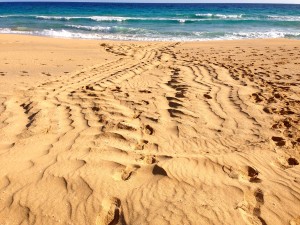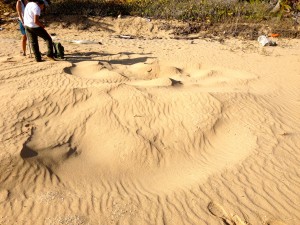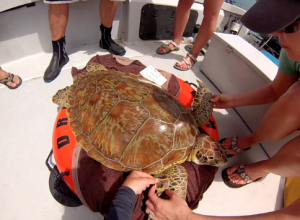Our morning began at an astonishing 6:30 am, when we all piled into the jeeps and drove to Brava Beach and Resaca Beach to perform morning crawl counts. Half of us went to each beach, accompanied by our new friends Carlos, Nilda , Christian and Carla, all wildlife biologists. Both beaches are part of the Culebra National Wildlife Refuge and are found on the north side of the island. After a short drive through the early morning, we parked and began hiking to our respective beach. The group bound for Resaca Beach had a hike that was described by Wendy as “shorter but steeper.” We all followed Christian through the brush and down the mountain, as he rightfully earned the “best mountain goat” award. Meanwhile, the Brava group had a similar experience on their trek. Nilda paved the way through gullies and around rouge horses on the “longer but more gradual” hike. Arriving on the sand, the view was gorgeous. The turquoise waters faded into the cloudless azure sky while surf-worthy waves crashed sharply onto the fresh, pillowy sands. Despite the idyllic scenery, now it was time to begin the work. We walked up and back across the beach in search of turtle tracks, which would signal that a leatherback female had crawled up the beach and nested in one of the past few nights. Unfortunately, the Brava beach was unsuccessful in discovering new nests, but were able to spy and few incubating nests that had already been staked. The Resaca group, however, was lucky enough to stumble (almost literally) on the tracks of a recent leatherback female. Everyone stopped and studied the zig-zig shuffles that she made on the west end of the beach. Christian and Carla explained that these tracks were probably made within the past two nights, but that it is almost impossible to determine the exact location of the egg chamber because of the intense “camouflaging” that the female performs before dragging their huge (yes, they’re way bigger than any of us ever thought) bodies back to the water. By marking this nest, biologists are able to correctly monitor the population status as well as protect the eggs as much as possible. After this, all the groups hiked to the jeeps and drove back to the house. A perfect start to another day in “paraíso”.
The second part of our day began after a short break to pack lunches and regroup. An orientation from Carlos prepared us for what we would spend the next several days doing: capturing, tagging and measuring sea turtles. Everyone packed into three speed boats and, after overcoming a few minor boat issues, we left for a nearby bay and know foraging site for green turtles. Today’s tactic was “tangle netting.” First the boats work to anchor a 200 meter net across the bay. Then, it’s up to us, the snorkelers, to swim parallel to the net and spot any entangled creatures. When a turtle gets caught, we must swim down and grab the frightened animal firmly by the carapace and bring it up to the surface. The pros, Carla, Christian, and Nilda were all incredible at helping us untangle the heads and flippers of our scaly friends. The turtles were then handed up to the boats where they sat under wet towels until processing. After the net was in the bay for around an hour, we regrouped and begin data collection. Each turtle was checked for previous tags, tagged if needed, measured, weighted, photographed, checked for any abnormalities (especially tumors) and released back into their wet homes. By the end of the day, after two net drops, we had scored a whopping 10 green turtles! In addition to that, we caught two spotted eagle rays in our nets, which was sad to stress out another creature, but really exciting for all of us to see something so beautiful! Don’t worry, they were released without a scratch. Back at the house, Matthew made us a wonderful pot of fresh pasta sauce for dinner, but there wasn’t enough so Wendy gladly went to buy some Prego. It’s the thought, Matthew!
We ate at the house and following the delicious meal, we had a lecture from Carlos on the sea turtle research and conservation efforts being undertaken in Puerto Rico, including the status surveys, recovery through management actions, and protection of habitats. Species that are most common in Puerto Rico are Green turtles (in Spanish “peje blanco”), Hawksbill turtles, and Leatherback turtles, making them the main focus in Culebra. Today we only saw Green turtles. Hopefully, tomorrow we can catch us some Hawksbills! Hurray!!
Click to see our video of catching Green Turtles!! : medium




Claire,
You are well on your way to catching up with Jenie and world adventures……miss you but know you are having the time of your life….BIG HUG TO THE TURTLES. Yes, soooooo cute!